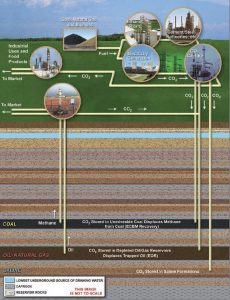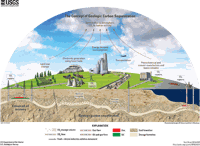
A Lake Charles company has embarked on an ambitious plan to create a vast repository 10,000 feet beneath the Earth’s surface for the permanent storage of up to 80 million tons of carbon gas now released into the air by Louisiana industrial plants.
The repository is actually a permeable layer of rock containing saltwater — similar to layers that once were drilled into to capture oil and gas in the area — located beneath a cattle ranch owned by Gulf Coast Sequestration LLC between the Sabine River and Lake Charles reported The Times-Picayune.
The company owns both the surface and subsurface rights to the land and plans to create a facility on the property where the carbon gas would be shipped and then pumped underground.
The company announced this week that it has begun the process to obtain a permit from the Environmental Protection Agency to operate the underground injection well specially designed for carbon storage. According to recent EPA public meetings, it could take a year or more before a permit decision is made.
“This filing is a long time coming and an exciting moment for GCS,” Gray Stream, president of Matilda Stream Management Inc., the owner of Gulf Coast Sequestration, said in a news release. “We have done our homework, and our permit application reflects our commitment to robust environmental compliance.”
In August, Gov. John Bel Edwards called Louisiana the “canary in the coal mine” for climate risk because of its increased loss of wetlands due to more intense hurricanes, more frequent Mississippi River flooding and sea level rise. He launched an ambitious program aimed at reducing the state’s greenhouse gas emissions by as much as 28% by 2025. He also set a “net zero” emissions goal by 2050.
Louisiana’s total carbon emissions come from a variety of sources, including car, truck and ship traffic; oil and gas production at wells; and the use of oil and gas for refineries, electric utilities and residential heating.
Carbon emissions increase temperatures in the atmosphere and the ocean worldwide. The gases cause ocean water molecules to expand and accelerate the melting of ice that adds to ocean water volumes.
The 2015 Paris Climate Agreement aimed to limit global temperature increases to no more than 2.7 degrees when compared with the average temperature for the pre-industrial period between 1850 and 1900. Today, global temperatures already have increased about 2.016 degrees from the pre-industrial average recorded between 1880 and 1900, according to NOAA.
Carbon sequestration has been one method suggested for reaching those goals. Another is finding a way to increase the amount of carbon permanently stored in sediment used to create wetlands under the state’s coastal Master Plan.
Gulf Coast Sequestration officials say they’re expecting to benefit from federal tax credits available to some industries for using carbon sequestration to reduce emissions. The project may also benefit from private, voluntary carbon credit markets that have been launched in recent years in anticipation of Congress eventually imposing additional carbon reduction requirements on industries.
Source: The Times-Picayune







